
Tourist Guide Venice

- Venice
- Piazza-San-Marco
- Sankt-Mark-Basilica-and-Campanile-Bell-Tower
- Doge-Palace-Venice
- Bridge-of-Sighs-and-the-Leads
- Rialto-Bridge-Venice
- Teatro-la-Fenice-The-Phoenix-theater
- Peggy-Guggenheim-Collection-Venice
- San-Giorgio-Maggiore-Campanile
- Murano-Island
- Burano-Island
- Cemetery-Island-of-San-Michele
- Lido-Venice
- The-Jewish-Ghetto-Venice
- Ca-Rezzonico
- Santa-Maria-della-Salute
- Giudecca-Island
- The-nightlife-of-Venice
- The-Arsenal
- Shopping-in-Venice
- Public-Transport-Venice
- Eating-and-Drinking
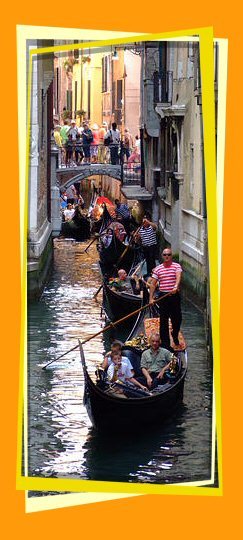
Venice
To many people Venice is the most beautiful city in the world. Of course this is a matter of personal taste however, only a few people are able to completely escape from the charm and magic of the bridges, the churches and canals that make up Venice. Even those who find New York or Shanghai or London more trendy and lively can not pass on two facts; Venice is one of the most famous cities in the world and it is also one of the most extraordinary. Where else will you find a city without any traffic? Where else is it impossible to follow the direction ‘straight ahead’ and where else does every short walk take you deep into history – not just that of Italy but of Europe? Venice has all of this to offer and much more.
Venice has a great name in history, architecture, cultural history and gourmet cuisine. In terms of size however, Venice is more of a lightweight. Officially the city covers 418 square metres, inhabited by over 250,000 people. By far the largest part of this is on the mainland where most Venetians live. ‘Mestre’ – one of these modern districts belongs just as much to Venice from an administrative perspective however, has little to do with the actual lagoon city. What the traveller sees in Venice is the historical centre ‘Centro storico’, which are the many small islands in the lagoon – several of which have never been inhabited. The historical centre that extends to the left and right of the Grande Canal is 7 square kilometres in size and can be superbly explored on foot, by water taxi and water bus. Of course one can also hire a gondola – this is the most stylish but of also by far the most expensive method of exploring Venice from A to B.
Speaking of expensive, Venice is not a holiday destination for bargain hunters. However it does not immediately have to lead to bankruptcy if one stays in the mainland. Generally everything in close proximity to the main attractions and sites is significantly more expensive than a few streets further away. This starts with an espresso and doesn’t stop at a postcard. If you are hungry or wish to quench your thirst, you will pay a small fortune in the cafes at St Mark’s Square; not necessarily for the Coca Cola, but for the world famous ambience that surrounds guests here. The same applies to all the small bars, ‘trattorias’ and shops surrounding the Rialto Bridge.
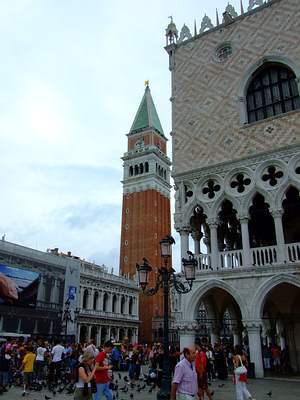
Piazza San Marco
Going for all inclusive Italy holidays will surely give you and your loved ones an excellent and relaxing time. This is undoubtedly a great travel destination for anyone seeking a peaceful time off that can relieve them of the stress brought by the daily grind. There are plenty of stunning and beautiful places that you can visit when you go here in Italy. One such place is the Piazza San Marco in the popular city of Venice.
The ‘Piazza San Marco’ – known as St Mark’s Square in English is the largest square in Venice. The city’s maze of streets and alleys regularly meet at one place hence the city can at times take on a claustrophobic character. However, there is nothing greater and more majestic than when entering St Mark’s Square. Turning into the square from one of the small, tight ‘Calle’ can take one’s breath away. Here the effect of the ‘Piazza’ is in great part an optical illusion as it is really not as big as it appears. The effect begins in that the square appears to be a rectangle, but in reality is a trapezium in shape. When looking from the opposite end onto the Basilica San Marco, it appears as if one is standing in a massive space however, in reality the ingeniously laid out Piazza is only 175 metres long. Buildings frame the left and right of St Mark’s Square which were once home to the procurators of the Basilica. Today one will predominantly find cafes and shops here with very high prices. The most famous café is ‘Caffe Florian’ – the oldest coffee house in Europe. It was opened in November of 1720 under the arcades of St Mark’s Square, and to this day has remained in the same place. Needless to say, over the centuries many famous guests visited this café. One of the most famous Germans who enjoyed spending time here bears the name Johann Wolfgang Goethe.
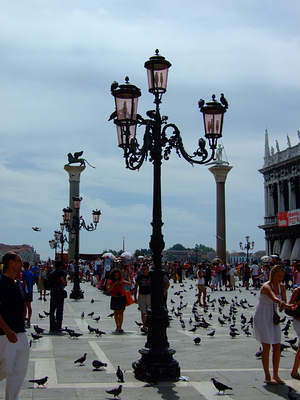
Unfortunately one needs a bit of cash in order to do the same here; the prices at the Piazza are really steep. One need not necessarily eat or drink here though. It is enough to simply be a part of the crowd of visitors that flocks from all around the world just to enjoy the square and the city.
For young people St Mark’s Square is a kind of unofficial networking place where you can meet people for a quick chat and sometimes arrange a date for the evening. If the bricks could talk they would reveal that the square had exactly this function for earlier Venetians. Many amorous adventures took place here – in the past this was mainly with the protection of masks during the famous carnivals. Back to the square itself; whoever wishes to make the location of Venice and its tangle of streets, bridges and squares come to life before their eyes, can best do so from the ‘Campanile’ or bell tower. This bell tower is located in St Mark’s Square and one can reach the top via elevator. The view is absolutely worthwhile.
St. Mark’s Basilica and Campanile (Bell Tower)
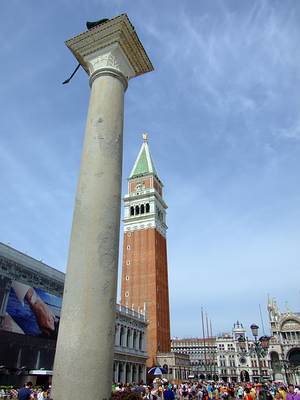
The Bell Tower may look somewhat old but in fact is relatively young – in Venetian terms by all accounts. The tower dates back to the early 20th century. It is an exact replica of its predecessor which collapsed on the 14th of July in 1902, shortly before ten o clock in the morning. Several days earlier cracks had appeared in the walls of the old tower. This was due to the removal of the metal frame inside of the tower in order to allow the building of an elevator; this was not accomplished however as the entire tower collapsed in on itself, sparking dismay all around the world.
The town council immediately decided to build a replica in its place. On St. Mark’s Day in 1912, on the 25th April the building was ceremoniously inaugurated. Not only is it enjoyable to rattle up the tower but one is also rewarded with a fantastic view of Venice.
St Mark’s Basilica seems like a building that has been covered with frosting. It took hundreds of years for the Basilica to assume its present form. Only in the final stages of construction in the 14th Century was this church of the Venetian patriarchs complemented with gothic-style elements. Everything else was created in a Byzantine style – which of course has a substantial background.
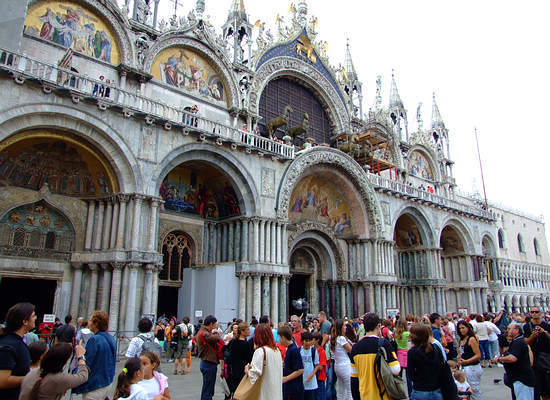
Venice was in its glory days a very powerful and influential seafaring republic. The ships were closely linked to the orient and brought luxury items like silk and spices from far away countries. From Venice these much sought after goods were sold throughout Europe and secured the wealth and supremacy of Venice. It is no hence no wonder that as a whole, the main church acts as homage to both Byzantine and the Orient. This was a way of demonstrating to the trade partners in the Far East how valued they were.
The real treasures of the Basilica however are located on its façade and inside the church. Covering a total surface area of over 4,000 square metres are resplendent mosaics that have been incorporated on gold – hence the basilica bears the nickname ‘Golden Basilica’. Some of the mosaic décor originates from the 13th Century. Incidentally, the Dome supposedly houses the remains of St Mark- the patron saint of the city. Who would dare doubt this? Mark is from Jerusalem; Jesus once ate supper in his mother’s house. Mark later became a missionary and was martyred in Alexandria. Venetian sailors took his remains with them at some point and buried them in the Basilica. During one of the many periods of construction, a builder fell off the roof and miraculously survived. Since that point the Basilica has become the patron saint of brick layers. His remains disappeared as a part of the Basilica burned down however thanks to a second miracle were retrieved again, and since then have been greatly revered in Venice.
Doge’s Palace
Doge’s Palace has become history set in stone. This building holds so many secrets and so many treasures from many different eras that a visit could almost make one giddy. To even attempt to capture the dimensions of this structure first requires a few facts: In total 120 Doges ruled over Venice from this palace for over 1000 years. The first Doge’s Palace to be built in this spot however, has for a long time no longer existed. The present building emerged in the 14th and early 15th Century during the era of Gothic style. The façade –which is present in almost all city views over Venice, is covered in gleaming white marble and decorated with numerous small arches, pillars and columns.
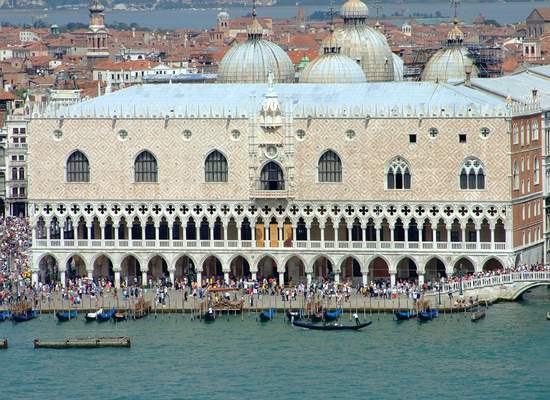
If the Doge’s Palace; which incidentally is located such that its front faces the lagoon, is entered via St Mark’s Square through the extremely impressive main entrance – the ‘Porta della Carta’ the exterior already exudes an almost unreal beauty that, from the inside it is simply overwhelming. The design of the interior began in the 16th Century. At this time Venice was not only at the height of its power – with a lot of money in the city coffers, but it also saw a cultural bloom. Accordingly the best painters of the era were hired to decorate the interior of the palace. Whether Tizian, father and son-Tintoretto or Paolo Veronese; not a single important name from amongst the elite painters is missing from this palace. Jacopo Tintoretto and his son alone painted the portraits of 96 Doges. Many of the paintings in the ornate reception rooms have huge dimensions and depict key scenes from the long history of the seafaring republic. In addition to this one can see a picture by the famous Flemish painter Hieronymous Bosch in the palace.
There are also some architectural features to admire which show that the Doges liked to make things comfortable. For instance the ‘Erizzo-room’ has a window which in the past had a special significance. From here a ladder led down into the hanging gardens of the Palace. Here the ruler could enjoy a breath of fresh undisturbed. Doge’s Palace with all its glory was of course designed to impress representatives of foreign powers and to express Venice’s wealth and primacy through architectural means. Woe to those however for whom Venice did not approve of. They experienced the other side of the Doge’s Palace – that of a ruthless court. Anyone that was condemned here was taken directly over the ‘Bridge of Sighs’ into the adjoining prison.
Bridge of Sighs and ‘The Leads’
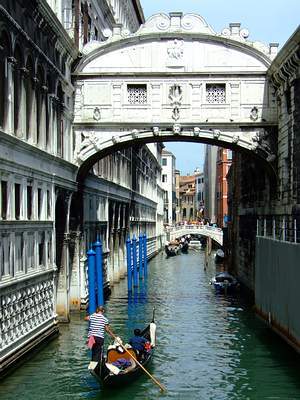
Whichever era and whichever country one is in – going to prison is not a desirable thing. For those condemned in Venice during the 18th Century however, it was particularly bad; above all if they were sentenced as a political prisoner. After the court hearing, captives were taken straight into the prison. The two buildings of the palace are joined together by a world renowned bridge – the ‘Ponte dei Sospiri’ or ‘Bridge of Sighs’. It would surely have been lamenting cries that gave the bridge its name. The prison at the other end was notorious and many prisoners did not leave it alive.
When many travellers visit this prison today then they above all wish to see the lead chambers. This is for two reasons. On the one hand the lead chambers were the most brutal and intolerable prison cells that one could imagine. They were deemed completely escape-proof until the most famous inmate that ever lived there, proved the Doges wrong and thus gave the main reason for the crowds of tourists that flock here. In a spectacular escape, Giacomo Casanova was able to regain his freedom. He was thereafter never to see Venice again however he never forgot the conditions of his incarceration. In 1755 Giacomo Casanova was convicted for blasphemy, free masonry, magic and no surprises here- for fornication. He was taken to a prison cell directly underneath the lead roof of Doge’s Palace. The roof gave the cells their name. The cells were tiny, but even smaller were the vents that aerated the cells. It became unbearably hot in them and many prisoners died. Giacomo Casanova took a long time before he processed his experience in the prison and his spectacular escape. He was imprisoned for an entire year before he could escape and begin his unsettled (love)-life across Europe’s ruling houses and beds. Many years later in his book ‘My Escape from the Leads’ he recorded his memories from that time.
Anyone who visits the prison wing of Doge’s Palace should also take a look at the so called ‘Pozzi’. These are 19 prison cells made of Istrian stone blocks that were not as hot as the lead chambers; however had other hardships in store. Often during the ‘aqua alta’ – the legendary floods of the lagoon city, the cells stood up to the beds under water. In comparison the cells of the new prison, that was completed in 1610 and can also be viewed, appear almost humane.
Rialto Bridge
Venice was built on over 100 islands and is traversed by 150 canals. It comes as no surprise then that this city has an incredible number of bridges. 400 is the estimated number, however the person who apparently counted them is unknown. One thing which is for certain is which of these many crossings is the most famous. This is the Rialto Bridge which impressively spans over the Grand Canal connecting the neighbourhoods of San Marco and San Polo.
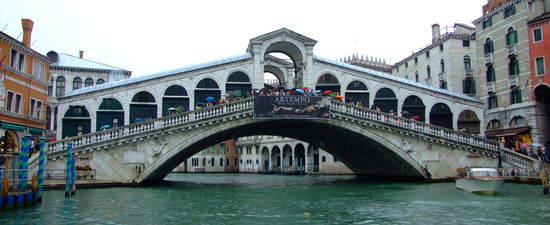
Why the Rialto Bridge has become one of the most photographed images of Venice has several reasons. One is surely in the former importance of this construction. When the bridge emerged it was the first bridge to span the Grand Canal and in so doing, allowed Venetians to walk over dry land from one district to another. Another reason is that for centuries Rialto was the economic heart of the republic. The great trading houses stood here and the influential banks had their palaces here. Luxury goods that had arrived from all corners of Venice and then sold all over Europe were also sold here. The architecture of the bridge enabled ships to sail safely underneath it. Is the Rialto Bridge beautiful however? This is a matter of taste. Its architect – Antonio de Ponte competed with his design against other renowned architects like Palladio and Michaelangelo; the aim came about in the late 16th Century and was to replace the rotten wooden bridge that formerly stood in its place. Perhaps the other architects had more aesthetically pleasing and better proportioned designs however Antonio received the contract, as he promised to deliver a stable and practical bridge.
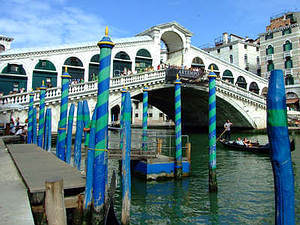
Today here one will find less of the economic and more of the tourist heart of Venice. To visit the lagoon city and not see the Rialto Bridge – this can not be so! Consequently day after day crowds of people push and shove over the steps, photograph each other and buy souvenirs from small shops that have emerged either side of the bridge. For young travellers the immediate vicinity surrounding the bridge – in particular on the San Marco side has become a popular meeting place to get to know other people. Those interested in Venetian cuisine can peer into the market of San Polo from here and perhaps be inspired to take a stroll through it; even if ones own kitchen lies a few thousand kilometres away – the market is simply a great experience. Fresh fish, meat, fruit, vegetables and herbs are always available and all with an exceptional quality that needs no comparisons.
Teatro la Fenice (The ‘Phoenix’)
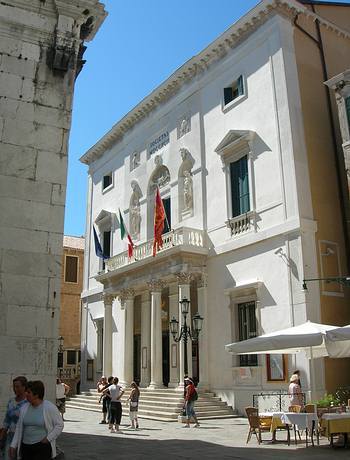
Source: pixelio.de Photographer: Biggi
Granted, an opera house is not necessarily the first port of call when young people visit a city. However in Venice things are often very different than in other parts of the world. As such the Teatro la Fenice (its full name being ‘Gran Teatro la Fenice di Venezia’) has its very own attraction for which there is neither an upper of lower age limit. As is often the case in Venice the history of the opera house is full of drama and passion. ‘Fenice’ is the Italian name for ‘Phoenix’ i.e. the legendary bird that re-emerges from its own ashes. This was the same for the opera house that holds its name, as the previous building that stood here fell victim to flames in 1773. There were quarrels and disputes between the company managing the theatre and the noble family to whom the theatre belonged. The managers eventually decided to build their own new theatre. In 1792 the new opera house was inaugurated and developed into one of the most important stages in Europe.
However the ‘fire devil’ soon struck again and in 1836 La Fenice once again sustained heavy damage from a fire. This time however, the building was quickly made playable in again and in so doing protected its excellent reputation. Giuseppe Verdi could hence continue to premier his operas in La Fenice, which he did with ‘Rigoletto’, ‘La Traviata’ and ‘Simone Boccanegra’. Even Richard Wagner was in favour of Venice, despite the fact that after unification, Italy in 1870 promoted the opera houses of Milan, Rome and Naples. Nevertheless Wagner chose La Fenice to first play his ‘The Ring of the Nibelung’. He sadly did not live to witness the premiere as he died immediately before it in Venice.
La Fenice retained its importance throughout the centuries and even after the Second World War it did not suffer any losses. But then came the 29th January 1995. The opera house was due to undergo renovations that were to be carried out by the electronic engineer Enrico Carella and his cousin Massimiliano Marchetti, amongst others. Instead the pair set the house on fire. The electrical engineer wanted to avoid a penalty due to delays in the work…
The Opera once again burnt down to its foundations; Carella fled and was not discovered again until 2007. He was spotted in Mexico, from where he was then delivered to the Italian authorities. The ‘Teatro La Fenice’ had already been operating again for three years – it was rebuilt to its original state using photographs and film documents.
Peggy Guggenheim Collection Venice
Strictly speaking, all of Venice is in some ways an open air museum: palaces, churches and bridges all by famous architects. There is barely a religious building that does not conceal a painting from a more or less (but mainly more) famous Venetian master. Even the museums display art with much local colour – the republic of Venice and all its regions that would later make up Italy always had an over abundance of talented artists. It may appear somewhat bizarre in this context then that one of the most famous museums visited in Venice, was neither founded by an Italian nor displays any Italian art exhibits. The talk is about the foundation of Peggy Guggenheims – so called ‘Collezione Peggy Guggenheim Venezia’. Her art collection is an attraction for lovers of all things modern and in addition, due to its location and the eccentric biography of its founder, exercises a great appeal to young people who come to Venice.
A love of art seems to have run in Guggenheim’s blood. The billionaire from the USA could also of course afford her hobby. Peggy’s uncle –Soloman R. Guggenheim founded the museum of the same name in New York. Peggy inherited her enormous wealth at an early age due to tragic events – her father died in the sinking of the Titanic. Hence she had the means to promote art and artists and they took advantage of this. Rebellious and unconventional she caused a stir in New York’s society and became a pioneer of avant-garde.
Peggy gave artists like Wassily Kandinsky, Marcel Duchamp, Jackson Pollock and Yves Tanguy attention and helped them to reach international stardom. This also applies to the German painter Max Ernst, to whom the patron was also married for two short years. In the forties the deep-pocketed American increasingly oriented towards Europe and eventually moved to Venice in 1947, where she bought the ‘Palace Venier dei Leoni’ located directly on the Grand Canal.
Here the collection of her favourite pictures can still be seen today – a first class collection of modern art which has no comparison to the other Guggenheim museums scattered across the world. From the garden the visitor can enjoy a fascinating view over activities of the Grand Canal and very close by one can also admire the sculptures from a range by Henry Moore. The garden is also a small burial site – here Peggy Guggenheim buried all of her beloved cats and dogs with a small monument dedicated to them.
For a good choice of hotels with discount prices, visit Accommodation in Venice for more information.
San Giorgio Maggiore and San Giorgio Maggiore Campanile
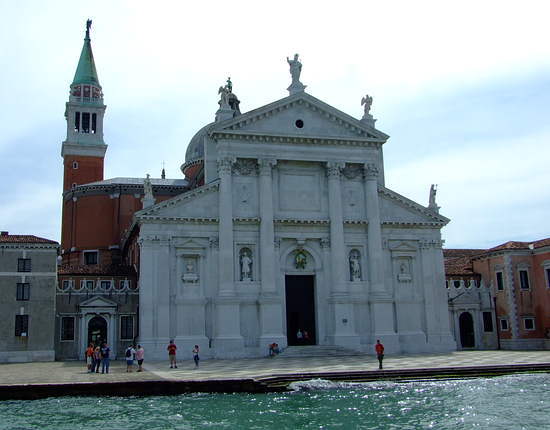
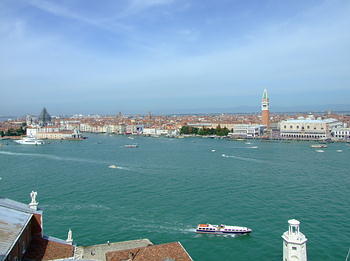
Only 3-4 minutes boat ride from the pier at St Mark’s Square is the island - San Giorgio Maggiore with its ‘Campanile’ (bell tower) and church of the same name. The Campanile is a replica of St Mark’s Campanile and was built in 1791. A lift takes one up to an observation deck. From here you have a magnificent view of the Doge’s Palace, St. Mark’s Church and indeed over the entire old city and its surrounding islands such as the Giudecca Island. The view in itself is worth the journey and entry price of approximately 3 Euros.
The construction of the Church of San Maggiore began in 1566. Worth seeing are two pictures in the choir room by Jacopo Tintoretto. One is of the ‘Last Supper’ and the other on ‘manalese’
Murano Island
Venice is a city that grew out of many smaller islands in the Venetian lagoon. Nowhere is this clearer than on a trip to the neighbouring island of Murano. Those who arrive by boat to Murano will feel as though they have just landed in a miniature Venice. Even here there are small canals, bridges, palaces and churches. Of course in Murano everything is one size smaller and despite its popularity and many tourists, is still a little quieter and less hectic than Venice. Murano is made up of five islands and presently has around 7000 inhabitants.
The island is world famous mainly for the skills of its glass blowers. Man has been able to produce glass since the antiquity. The knowledge of this skill was lost however, first in Europe and only returned to central Europe again through trade between Byzantine and Venice. Venetians welcomed the art of glass blowing however they greatly feared the fires that could result from the flames. In the maze of narrow streets in Venice, fire had a devastating effect; hence the glassblowers settled far away on the island of Murano. They have remained there ever since and have remained unrivalled in their art.
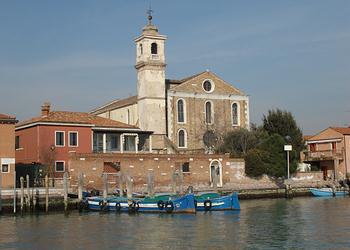
Source: pixelio.de Photographer: Claudia Guth
On the waterfront of Murano rows of glass shops stand one after the other. Here the visitor is presented with the entire range of the Murano glass industry. From Kitsch animal figures to super expensive elegant glass designs from renowned studios- everything is available. It is simply a must to peer over the shoulder of a Murano glass blower in action. Many workshops are open for visitors and almost always without cost.
Another must is a visit to the Glass Museum – the ‘Museo dell’Arte Vetraria’. Comprising around 4000 objects here the history of glass is reconstructed. Almost everything is based on the thousand years in which Murano has produced glass. In the museum there are also some glass exhibits which originated in ancient Rome.
It is not glass but rather stone that dominates the ‘Basilica di Santa Maria e Donato’ – the main church of Murano. It was founded in the 7th century and completed to its present form in 1150. This makes it one of the oldest buildings in the entire lagoon. Worth seeing are its mosaic floors from the 12th Century.
Burano Island
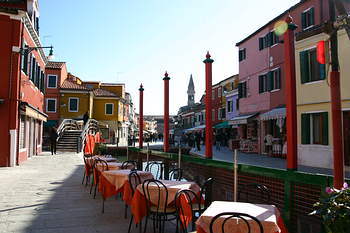
Source: pixelio.de Photographer: Hanni Flicker
What is glass for Murano Island is lace-work for Burano. Here some of the most luxurious laces in the world are made. But be careful – what is available in the many small souvenir shops has less to do with the dexterity of women and more to with the sophistry of the shop owners. The low cost laces almost always originate from the Far East; the original lace of Burano on the other hand, is rare and very, very expensive.
Burano is much smaller than Murano- the island has just 5000 inhabitants. However many boats of tourists come here, although less than visit Murano. Burano is thus a great tip for all those that wish to take a breather from the crowds in ‘Bella Venezia’. The journey in itself through the lagoon is a delight. Once on Burano it is easy to see why this island attracts more than the average number of painters and photographers. In earlier days nearly all the men on this island were fishermen and all the women made lace. Life was not poor, however far from being rich. Hence the small houses of the fishermen are closely nestled one like the other. All the houses are the same? This may apply to the construction however not for the colours. Each house stands out from its neighbours by its colour. This creates a unique and picturesque atmosphere and is so doubly if the colours are reflected in the water. In any case don’t forget your camera!
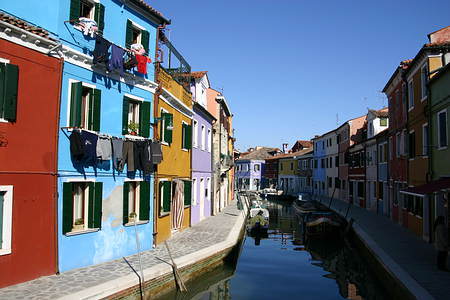
Source: pixelio.de Photographer: Hanni Flicker
The lace makers and lace embroiderers from Burano were almost forgotten in the mid 19th Century. At that time the new technologies that ‘thanks’ to the industrial revolution were now implemented and made a reality by machines, had a big impact. Their craftsmanship was almost pointless now, and as a result fewer women learnt this skill. It finally came to a point that only one single old lady knew the secret of lace making that had previously been passed down from generation to generation. As a consequence, gentlewomen of the Italian society pulled the ‘emergency breaks’ and in 1872 founded the embroidery and lace school ‘Scuola di Merletti’. It was personally promoted by the most noble of gentlewomen at that time – Queen Margaret and of course was located on Burano where one can still visit it today.
Cemetery Island of San Michele
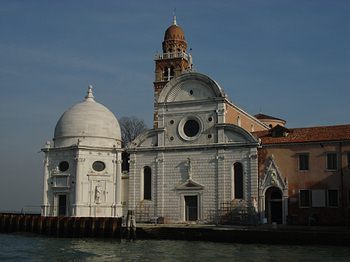
Source: pixelio.de Photographer: Claudia Guth
Even if a trip to Venice signifies bustle and brimming with life, here as everywhere else people also die. For its dead, the lagoon city has reserved its own island – the Cemetery Island of San Michele. It has its own special appeal and every year attracts tens of thousands of tourists.
One can reach San Michele by- how could it be otherwise- boat. The liner that later stops at the lagoon islands of Murano, Burano and Torcello first stops at the pier of San Michele. It is not unusual to see a coffin appear at the smaller neighbouring pier. The last journey in Venice is always taken on the water – usually on a motorboat; sometimes coffins will also arrive on a gondola.
The cemetery of San Michele is in the form of a Greek cross. For travellers in addition to the monastery, the old part of the cemetery next to the graveyard is of particular interest. Not only is there a peaceful, friendly atmosphere but also many famous people have found their final resting places here. However those who wish to see the graves for example of Igor Strawinsky, Ezra Pound or Helenio Hererra have to have a lot of patience and be prepared to search for them. In contrast to other cemeteries the graves of prominent deceased are not marked. Also because ‘fans’ rarely come to San Michele just to visit a single grave, the resting places are not immediately identifiable through excessive decorations.
It is interesting that during earlier days, the dead were separately buried according to their religious denomination. It is particularly clear to see this in the protestant part of the cemetery. Here there are very few locals as Italians are predominantly Catholic; instead one will find the resting places of ambassadors and their families from Nordic countries.
The way back to the pier is the way back to the living. In the impressive cloister of the old monastery from the 13th Century, one can relax and sun oneself. Here one will also meet people who, don’t live on San Michele but who work here – like the gardeners. Neither the renaissance church ‘San Michele in Isola’ nor the hexagonal chapel ‘Cappella Emiliani’, are accessible to the public. With a little luck however one can sometimes catch a glimpse of the inside.
Lido
A trip to Venice is simply not complete if one has not been to the Lido. The name originates from Latin and is derived from the word ‘litus’ or beach. Venice’s Lido is a long stretched out sand bar that reaches from Jesolo to Chioggia, and that shields the vulnerable city from the open sea. It was not until the 19th Century however that the Lido was discovered as a tourist location. Since then more and more luxury hotels settled here and turned the Lido with its incredible views over Venice, into a fashionable seaside resort. For centuries the nobles and aristocrats from Europe would meet here to enjoy a few idle weeks in the refined elegance of Venice and to make the most of the summer. During this heyday before the First World War and even between the world wars, a lifestyle and atmosphere existed here for which the Lido is still famous for today. Whoever wishes to gain insight into this time should read the Thomas Mann novel ‘Tod in Venedig’ (Death in Venice), which captured the Lido, its hotels and its inhabitants in world literature. Once a year of course the Lido stands in the spotlight; namely the International Film Festival of Venice is held here annually which particularly in the last few years has increasingly attracted more stars and starlets.
The Lido is the ideal destination if you are travelling with children or if whilst on a trip to Venice you want to walk around without any crowds and really let off some steam. Here at any time of year you can take a long stroll along the beach, collect sea-shells, and then sit down for a coffee or a small glass of wine- as is typical in Venice in one of the many hotels.
In the summer one can of course also bathe in the Adria. Although it is said during carnival time the Venetians will ‘let themselves go’, at other times of year they are somewhat more prude. It is therefore advisable to rent one of the small beach huts or to change in an otherwise shielded manner – the main thing is to remain decent. Even today one can find several 5-star hotels on the Lido; all in all however, this part of Venice- in which cars are allowed to be driven has lost some of its exclusivity.
The Jewish Ghetto
In the district of Cannaregio there is an island which for centuries had to fulfil a very specific task: to settle the Jewish population of Venice here. The authorities of the maritime republic by no means allowed the Jewish and Christian inhabitants of the city to live together. Their aim was to avoid attacks and riots. Despite the fact that living conditions in the Ghetto (hence the name of the district which was later adopted worldwide) being cramped and the Jews being heavily taxed, this procurement was not all disadvantageous. Venice granted in exchange, protection from the Inquisition and also prosecuted any Venetians that entered the Ghetto and caused trouble there.
The first Jews came to Venice in the 5th and 6th Centuries. Most were German – at that time their home land was still called the Holy Roman Empire of the German nation, and wished to make money in Venice from their goods. As traders they were certainly welcome in the lagoon city but not as citizens. As a result they had to live on the outskirts in ‘Fondaco dei Tedeschi’ (The German’s Inn). This name still bears witness to their early presence there.
In the course of history the acceptance of Jews in Venice was characterised by a constant flux. During difficult economic times they were courted and they were even given new rights – such as the right to acquire buildings in Venice because the money that flowed through their pawn shops was needed. Once the crises were over the tensions would begin again and the Jews were harassed and discriminated against. For a time ministers seriously posed the question as to whether the salvation of Christians would be damaged on regular contact with Jews. On the 29th March 1516, Venice brought and end to this back and forth situation. For the first time in history the Jewish population were assigned a clearly defined territory in which depending on how you look at it, they either had to or were permitted to settle. The district was at that time called ‘Ghetto Novo’ and became the name for all subsequent ghettos that followed. It was Napoleon at the end of the 18th Century who first put an end to this order as his troops conquered Venice. The Jews remained in the Ghetto but on a voluntary basis. From 1943 the German authorities deported the last few Jews who lived in the Ghetto; only a few ever returned.
Today several hundred Jews once again live in the Venetian Ghetto that is visited by many tourists. Between two synagogues, a museum and many shops that produce speciality dishes like kosher meat dishes and ‘Matzoh’, one can get to know Jewish daily life. For victims of the holocaust there is a relief by the Italian sculptor Arbid Blatas.
Ca' Rezzonico
Over the centuries, Venice and its palaces have enthralled and inspired the travellers and aesthetes of the world, the painters, sculptors, musicians, makeup artists and writers. Therefore whoever visits the lagoon city simply must see one of the Palaces from within. This is easily accomplished in Ca’ Rezzonico. This Palace has belonged to Venice since the mid 20th Century- more precisely since 1936, and now houses a museum. Here one can not only study the architecture of the large palaces and catch a great view of the Grand Canal, but also simultaneously visit alternating but always exclusive exhibitions.
Like many other palaces Ca’ Rezzonico also has an eventful history. ‘Ca’ is quite simply the abbreviation for the word ‘Casa’ which means ‘house’ in Italian. Originally two houses stood at the site of the palace. In 1649 however the owner at the time decided to extend to something bigger, more beautiful and taller. The plan soon exceeded his means and the palace remained unfinished for some time. In a painting by the famous Venetian painter- Canaletto the half-finished palace was captured for posterity. It did not take too long until there was a new owner and for whom lack of money was in no way a problem. The Rezzonico family had just spent a fortune buying into Venetian nobility when they added Ca’ Rezzonico to their shopping list. The building was finished to the highest standard and for the interior, renowned artists like Giambattista Tieplo, were commissioned.
The last son of the Rezzonico family died in the year 1810; thereafter the palace frequently underwent a change in ownership until finally the state bought the opulent palace. In the mean time everything that could be moved from the interior has left the house. Hence for those who are interested in seeing how life was during the hey-dey of the palace will not obtain their money’s worth in Ca’ Rezzonico. Here it is more about the façade, the presentation and the layout of the house and of course its very high ceilings and wall-paintings.
A vivid impression of the former furniture and decoration of ceremonial palaces can be better obtained in the ‘Palazzo Mocenigo’ in which some of the original furniture and décor is still available and in fact still stands in its original place.
Santa Maria della Salute
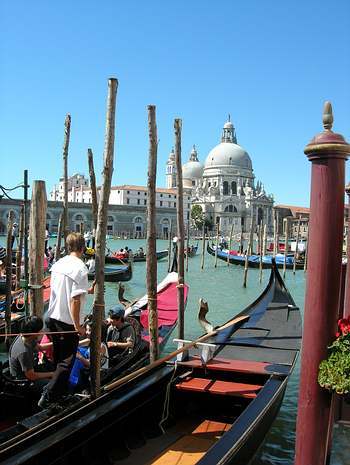
Source: pixelio.de Photographer: Biggi
The ‘Santa Maria della Salute’ church occupies one of the most prominent places in Venice. Directly on the ‘Bacion’ at the beginning of the Grand Canal and opposite Saint Mark’s Square and Doge’s Palace, the church has importantly defined the city’s landscape since the mid 17th Century and can be seen on countless views.
60 years passed between the decision to build the church and the actual inauguration – and as is oft the case in Venice the construction is closely associated with an important period in the city’s history.
The year was 1629 as the Black Death once again struck the lagoon city. This time the plague raged for so long that it took a third of the population with it. Towards the end of 1630 the Doge at that time - Nicolò Contarini didn’t know what else to do to end this plague, than to vow to build the Madonna a new church. The ‘Mother of God’ heard him clearly- in any case the plague finally ended. Now the task was to find a suitable spot for the new church; the decision led to this prominent spot. For a long time the shabby apartment buildings and the old customs building that stood here opposite Venice’s ‘good room’- Saint Mark’s Square had been an eye sore for the Doge. Now the occasion had finally come to demolish it and to replace it with a magnificent building. An architectural competition was quickly announced which the 33 year old Baldassare Longhena was to claim for himself. He was henceforth to devote his entire life to the building but sadly did not live to see its completion. Longhena had already been dead for five years when the Santa Maria della Salute was inaugurated in 1687.
The plans of the young architect were revolutionary and stood out from the way in which things were ordinarily built at this time. In order to make his plans a reality Longhena had to cope with enormous technical problems. There is differing information as to how many wooden piles the Santa Maria della Salute rests on. Sources agree however that it is definitely more than a million oak piles each four metres in length that bear the enormous weight of the church. To avoid making the church heavier than necessary, Longhena had the dome made of a double-walled wooden construction which was then plastered.
As impressive as the building is from the outside, as plain it is on the inside. At first glances the Santa Maria della Salute appears relatively austere in comparison to many other churches – one should be prepared for this on a visit. Here it is intentionally much less focussed on the decoration with colours and pictures rather more on the effect of natural light.
Giudecca Island
Giudecca Island is located only a few minutes drive by Vaporetto (waterbus) from Saint Mark’s Square in the south of Venice. There are many reasons not to miss out a trip to this island when visiting Venice. One of the main reasons is obvious – it provides the most famous view over the entire city. Nowhere else will one obtain such a view over Doge’s Palace, Saint Mark’s Square, the votive church Santa Maria della Salute and the entrance to the Grand Canal.
Once one has satisfied their appetite and seen enough of the first reason one can turn their back on the Bacino and explore the island itself. It is small – measuring only approximately two kilometres in length and some 300 metres in width. For this manageable area La Giudecca has amazing things to offer and aside from this it has often featured in German literature. The most impressive building on the island is without doubt the ‘Il Redentore’ (Church of the most holy Redeemeer). The architect of this balanced structure is no other than Andrea Palladio who began its construction in the 16th Century. Just like the church – Santa Maria della Salute that lies opposite, ‘Il Redentore’ is also a votive church that marked the end of a plague epidemic. In addition on La Giudecca one will find ‘Sant Eufemia’ – one of the oldest churches in Venice that dates back to the 9th century. The third of the sacral churches is the ‘Chiesa delle Zitelle’.
The island also has several worldly attractions to offer. At its western side for instance there is a large building in a Gothic revival style that until the outbreak of the Second World War housed the largest pasta factory in Italy – the ‘Molino Stucky’. A German architect by the name of Hannoveraner Ernst Wullekopf was commissioned for the extension of this brick building. In the post war period this building stood empty for a long time and fell progressively into disrepair. After a transitional period in which it was used as an exhibition space and also in which it had to deal with a fire, it today stands as a hotel belonging to an international chain of hotels. Not far from here is a film studio which is still very much used for shooting films.
As small as it may be, in German literature Giudecca Island has been made big. It has been mentioned by Goethe and Schiller as well as by Theoder Fontane, ETA Hoffman and Hugo von Hofmannsthal. Its most famous resident was Michelangelo who lived here for three years in a kind of voluntary exile.
The nightlife of Venice
Nightlife and Venice – these are not two concepts that directly contradict each other yet at the same time don’t really fit well together. At least not when talking of the historic centre of Venice. On the Lido and in the districts of Venice that lie on the mainland, things are a little different. But first let us define- what is understood by the term ‘Nightlife’? If one means pubs, discos and clubs that are still open past 1am then the nightlife in historic Venice fairs rather badly. Just like there are very strict fire-safety rules here, there are just as strict rules on noise pollution. The Venetians would otherwise almost certainly never get any sleep. The city is built very closely together and voices and music are greatly echoed and intensified in the small alley ways. This doesn’t mean that one can’t have any fun in Venice. Whoever wishes to dance the whole night through however has to leave the city centre for the mainland or the Lido. Here everything that the fun-loving heart desires is on offer- from pubs with live music to discos, casinos (on the Lido) and establishments with live shows…
Conversely those who simply wish to have a night out the ‘Venetian way’ will find their money’s worth in the historical city centre. It is said time and time again that Venice is not just historical to look at but also with regards to its population, is not a ‘young’ city. This is however only half the truth. In reality Venice has many students and like students anywhere else, they also very much enjoy a night out. The bars in which they and other young Venetians can meet in the evenings are concentrated around Campo Santa Margherita- located close to the university (Università degli Studi Ca' Foscari).
The restaurants at Saint Marks Square are open the longest out of all the bars in Venice. Here one can have drink until mid-night or sometimes even till 1am. However, one should gain no false impressions. These pubs are hardly ever visited by locals and are primarily geared towards tourists; hence drinks or small snacks cost a small fortune. So why not leave the ‘nightlife’ as you know it and do as the Venetians do? They may not stay awake till all hours of the morning but they also do not leave the house so late. In Venice a glass of wine is at the latest already drunk in the afternoon – the so-called ‘Ombra’. This is the word for shadow and signifies the point in the day when the sun slowly begins to sink. Then it is time to have the first drink in one of the countless ‘Bacari’s’ of the city. It may seem relatively early but an ‘Ombra’ only consists of 100ml content.
Whoever wants to do things in style should go to ‘Do Mori’. This is Venice’s oldest stand-up bar, and lies very close to the fish-market at the Rialto Bridge in the ‘Calle dei Do Mori’. For 500 years Venetians have enjoyed wine here. Today one can choose from hundreds of different wines. This has not always been the case however the countless vessels and copper pots that hang from the ceiling of the Do Mori have seen many generations of locals and visitors. Likewise there is an institution called Harry’s Bar located directly behind Saint Mark’s Square in the Calle Vallaresso S. Whoever wishes to eat in the restaurant upstairs must book a table in advance. One can still however spontaneously drift into the bar and simply have a drink. The best thing is to try the world famous ‘Bellini’ mixer was invented here; not cheap but ‘very very Venice’.
The Arsenal
It is rare to find a location in Venice where the directions ‘straight ahead’ are included. Here comes one of those rare exceptions: From Doge’s palace walk straight ahead along the Riva degli Schiavoni – past the famous Hotel Danieli and Londra Palace – and finally arrive at the Arsenal. This is the name of the historic shipyard that for many hundreds of years was of vital importance for the maritime republic of Venice. Its area covers about ten percent of the historic centre.
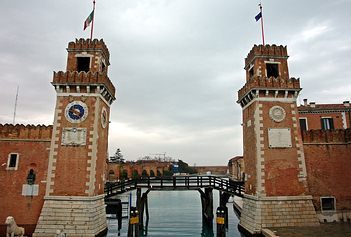
Source: pixelio.de Photographer: Thomas Max Müller
The construction of the Arsenal began in the year 1104 under the authority of the Doge Ordelaf Falier. Originally the site consisted only of two marshy islands in the district of Castello. During the course of its long history as a shipyard, arsenal, naval base and gun-powder depot the Arsenal was expanded several times. Whoever visits the freely accessible Arsenal today will need a little imagination to draw out an image of the activity that once occurred there.
After centuries of zealous activity the Arsenal today appears quiet- almost deserted and is now more of a place where one can find peace from the hectic of Venice. During its best of times, around 30,000 people worked tirelessly on a daily basis to build and maintain the ships that the maritime republic of Venice needed for control over the Mediterranean. There is hardly an area of history in which the Arsenal did not play a certain role. For the history of the economy for instance, it represented the largest manufacturing plant that ever existed in Europe before industrialisation. In literary history it is none other than Dante Alighieri (1265-1321) who extolled the Arsenal in his the ‘Divine Comedy’ and impressively described the noise, heat and pressure production. In architectural history it is both towers to the left and right of the entrance to the Arsenal (Ingresso all’Acqua) that caused a furore; they are the first buildings in Venice to have been built in the style of the Renaissance.
Here is an example to give an idea of what once occurred in the now almost unreal Arsenal: in the year 1570 the Venetians fought against the Turks. Within two weeks 100 galleys were built within the Arsenal for the naval battles. This was only possible through extremely efficient organisation. All components of the galleys were standardised and were kept in the wings of the Arsenal till needed. Even Venice’s merchant fleet had to stop here in emergencies. The merchant ships were so cleverly constructed that they could easily be converted into war ships.
Shopping in Venice
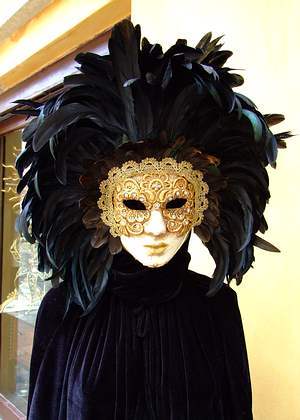
For the ‘shopaholic’ in Italy that wants to buy the big branded fashion labels at a cheaper price, Milan with its designer-outlets is highly recommended. Venice has much to offer, however a classic shopper’s paradise it is not. This in no way means that one can’t spend money here – on the contrary! The products that one can take home from here are simply not of the usual type. Typical Venetian souvenirs for instance are masks that are worn in the Carnival of Venice. The price ranges from cheap to almost unaffordable. The same applies to the glass from the glass-blowers on Murano.
Also expensive is genuine Burano-lace- marbled paper however is a Venetian souvenir that is well affordable. Below is an overview as to where one can discover what: In Castello and San Marco are the most expensive shops of the city, with international fashion labels and high-quality shops for glass, porcelain, and silver and luxury household linen.
In La Fenice one will find the most antique dealers – a shopping spree in Canareggio is ideal for those looking to buy something original for very little money. At the Rialto market between the Rialto Bridge and the ‘Pescaria’ one can buy local culinary specialities between the hours of 8am – 4pm. Local delicacies can also be found at Giacomo Rizzo (address: Calle San Giovanni Crisostomo 5778) – how about pasta in a gondola-shape for instance?
Public Transport in Venice
The cheapest and funniest way to travel in Venice is by using the Vaporetto. This is the name given to the water buses that are constantly on the go on the Grand Canal. With them one can explore the entire lagoon. In addition to stopping at the cemetery island of San Michele, they also stop at Murano, Burano and Torcello and also run so close to the un-inhabited islands of the lagoon that one can also gain a good overview of them. Like everywhere else in the world single tickets are comparatively more expensive. It is cheaper to purchase a 24 hour ticket or alternatively a three-day or one-week ticket.
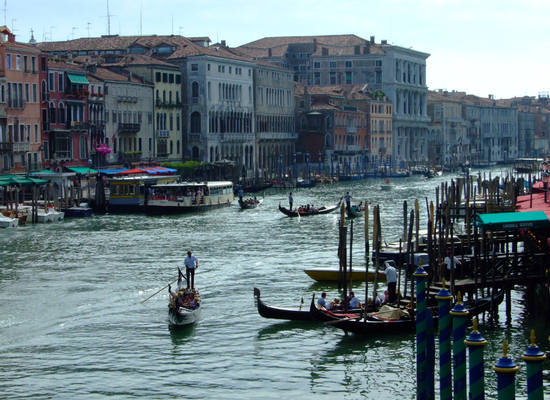
One can obtain tickets in selected cigarette and newspaper kiosks as well as at the landing spot of the buses. Whoever simply wishes to cross the Grand Canal but can’t find a bridge can use the small ferries known as ‘Traghetti’. On these one will be mainly amongst the locals rather than tourists and for less than one Euro will be quickly ferried across. There are very few seats- reserved for the elderly or for those feeling unwell. Those in a hurry and for who price is not an issue can of course hire a sleek water taxi. Nevertheless, it is wise to inform oneself about the price before setting off. Gondolas are rather unsuitable for getting from A to B around Venice. A ride on them is more of an (expensive!) attraction and most tours with a gondolier end where they began.
Eating and Drinking
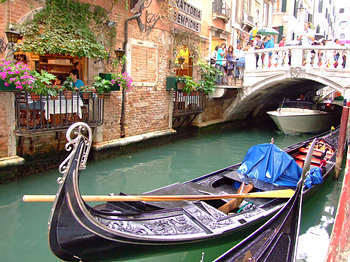
In Venice there are an incredible number of possibilities to eat and drink something. The ideal thing here would be to go to a restaurant that is as equally good as it is expensive. As this is not usually the case here is some basic information as to how one can not only satisfy one’s appetite but also enjoy the culinary delights of Venice. The most important thing is to get as far away from St Mark’s Square as possible before finding a place to eat. Even the immediate vicinity around the Rialto Bridge should be avoided. Regardless of the locality – in the vicinity of these two tourist resorts one will pay such hefty prices that it may spoil the joy of a meal! Okay far enough away? Now things can get going. If you go into a tavern you will find yourself in a traditional wine cellar - again where you can also eat. The menu will be manageable and the prices too.
In a ‘Baccoro’ you will find yourself in the heart of every-day Venetian cultural. Here aside from wine, there is wine, and wine and also small appetisers and snacks. It only becomes ruinous when one loses track over the number of glasses that have been drunk. A little more expensive are the trattorias and restaurants. Here in addition to the prices shown on the menu one has to add extra costs for service charge (approximately 15%), and also a tip of 10% is expected.
If you only want a quick drink in between then one will be well advised with an ‘ombre’. That is 0.1 litres of wine that the Venetians sometimes have standing up in the afternoon. Thirsty for coffee? Then one should order an ‘americano’- this comes close to a German filter coffee. If however one orders a ‘caffe’ one can expect to receive an espresso.
[ © Das Copyright liegt bei www.europe-sightseeing.com | Informationen und Sehenswürdigkeiten von Europa, Städte und Landschaften]
nach oben | Home | Sitemap | Impressum & Kontakt
©: www.europe-sightseeing.com